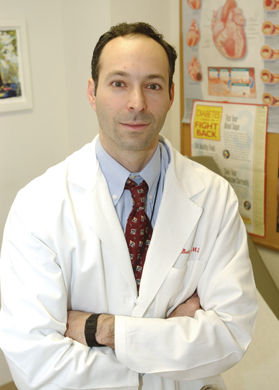Disease Detective As part of the EIS at CDC, Dan Budnitz brings a prevention approach to drug injury. Everyone faces that first big, urgent assignment, cropping up unexpectedly at a new job. Even so, not many have a story like the one Dan Budnitz, 98MD, 97MPH, can tell. A few weeks after joining the CDC, he was sitting in a training session when someone interrupted to tell the speaker to turn on the news. The date was September 11, 2001. Later that day, bidding goodbye to his wife, Tina Paul, 96MPH, and their two-week-old, firstborn son, Budnitz boarded a plane to New York. He was part of a team answering a request from the city’s health department for federal help in dealing with the terrorist attacks.
Budnitz came to the CDC as an Epidemic Intelligence Service (EIS) officer with CDC’s Injury Center. Begun in the 1950s to combat a perceived bioterrorism threat from the Soviet Union, the EIS has grown into an international disease detective program that examines outbreaks such as Legionnaires disease, Ebola, and HIV, as well as the control of diseases from malaria and polio to small pox. The service also works with chronic diseases and injuries, the area where Budnitz’s assignment lies. He finished the two-year EIS training phase in 2003 after completing an internal medicine residency at the Hospital of the University of Pennsylvania. Upon joining the EIS program in a matching process he likens to fraternity rush, Budnitz gravitated to the Injury Center. “I chose the Injury Center for a combination of reasons,” he says, “including that they were doing some groundbreaking work in electronic data standards—trying to get the computer systems in public health and hospitals to all talk to each other.” Also, the chance to contribute to an emerging field held appeal for him. “Injury is a newer area for public health,” Budnitz says, “and not all the aspects have been worked out yet. There are a lot of opportunities to keep learning and improve health in this area. Intervening in adverse drug eventsWhile he remains on call for emergencies, Budnitz spends his time these days on a program kicked off last summer to gather information about adverse drug events. “An adverse drug event is simply when someone is taking a drug for therapeutic reasons, but instead gets injured by it,” he says. “Examples include when you have an allergic reaction to a drug, if you have a severe side effect, if there’s a medication error, or if you just get an overdose.” His studies focus on outpatient drug events. “Whereas in the hospital setting, the patient is a passive receiver of drugs, outside the hospital the patient plays a central role,” Budnitz says. Some of the public health interventions the CDC is pursuing focus on environmental modification initiatives such as safety caps or limiting the dosage or number of pills. Budnitz and his team at the CDC are trying to get a sense of how significant the problem of patient safety really is. One of their current projects looks at data in hospital emergency departments, where many victims of adverse drug events are treated. The Injury Center works in tandem with the Consumer Products Safety Commission with approximately 60 hospitals across the country to enter chart information into a database. In the summer of 2003, the center taught data gatherers at the National Electronic Injury Surveillance System how to extract and enter medication injury information. By this August, they will have a year’s worth of data and be able to pinpoint how many people came to emergency departments with adverse effects from a drug. “If you want to reduce outpatient adverse drug events, you need to intervene with the people that administer the drugs—or in other words, the patients themselves. That’s where injury prevention and public health can play a role,” Budnitz says. The CDC response may include recommendations on improved drug labeling and public education campaigns against actions such as taking another’s prescription medication or storing drugs where children can reach them. The outcome of the study will guide the researchers on where to concentrate efforts. Budnitz’s career in public health is a natural extension of his interests in political science and medicine. A Woodruff scholar at Emory, Budnitz earned a combined MD/MPH degree that gave him the training to use public policy to improve health. Budnitz maintains his ties to Emory as an assistant clinical professor of family and preventive medicine, treating patients at the DeKalb/Grady Neighborhood Health Center. By Mark Farmer, a freelance writer and photographer in Atlanta.
Instamatic Informatics | Veteran Epidemiologist | The Human Strain | Expelling the Fiery Serpent Corps Class | Class Notes | Rollins School of Public Health
Copyright © Emory University, 2004. All Rights
Reserved. |

